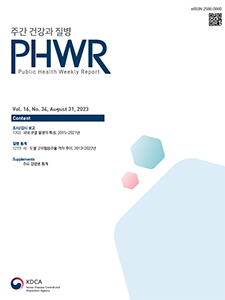Current Issue
Vol.16 No.34, August 31, 2023
-
Surveillance Reports 2023-08-31
 1
1
 853
853
 242
242
Characteristics of Domestic Q Fever Cases, 2015–2021
In Sook Shin, Young Suk Kim, Yeong Chang Seo, Ji Yeon Lee, Kyung Won Hwang*
Public Health Weekly Report 2023; 16(34): 1203-1218 https://doi.org/10.56786/PHWR.2023.16.34.1 Abstract
AbstractQ fever is classified as a third-class zoonotic disease that is mainly transmitted to humans through the respiratory system by aerosolization of dust generated in the process of handling livestock infected with Q fever (Coxiella burnetii). A total of 642 patients with Q fever were reported between 2015 and 2021. Until 2017, the incidence was less than 10 per year; however, this increased and peaked at 163 in 2018 and decreased to 50–60 from 2020 to 2021. The incidence per 100,000 population was 1.2 in Chungbuk, 0.6 in Chungnam, and 0.6 in Jeonnam. The number of cases increased from May to July, and the number of infected livestock increased from April to May; there was a positive correlation between the number of breeding heads and the region of Q fever occurrence in the human population (correlation coefficient, 0.48). The Korea Disease Control and Prevention Agency-Animal and Plant Quarantine Agency established a joint response in 2022. This is expected to help identify trends in cattle fever outbreaks and enable proactive responses to minimize infection in exposed populations.
-
QuickStats 2023-08-31
 0
0
 854
854
 256
256
Trends in the Prevalence Gap of High-risk Drinking between Cities or Provinces, during 2013–2022
Public Health Weekly Report 2023; 16(34): 1219-1220 https://doi.org/10.56786/PHWR.2023.16.34.2

pp. 1433~1461
Most Keyword
?
What is Most Keyword?
- It is the most frequently used keyword in articles in this journal for the past two years.
Most Read
-
Waterborne and Foodborne Disease Outbreaks in the Republic of Korea, 2023
Myung-Jae Hwang, So Yeon Park, Hyungjun Kim, Se Jeong Yang, Sungchan Yang, Jin Seon Yang
Public Health Weekly Report 2025;18: 17-32 https://doi.org/10.56786/PHWR.2025.18.1.2 -
Implementation Plan for the Coronavirus Disease 2019 Vaccination for the 2024–2025 Season: Recommendations of the 6th Expert Committee on Immunization Practices
Hyewook Hwang, Wookeon Lee, Seohyeon Ahn, Young-Sook Choi, Seunghyun Lewis Kwon, Dongwoo Lee, Eun Hwa Choi, SokGoo Lee
Public Health Weekly Report 2025;18: 90-102 https://doi.org/10.56786/PHWR.2025.18.2.3
Editorial Office
+82-43-719-7569





 Full Text
Full Text Cite
Cite


